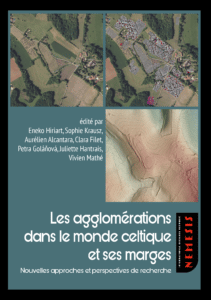UN@ est une plateforme d'édition de livres numériques pour les presses universitaires de Nouvelle-Aquitaine
Auteur : Tom Moore

Department of Archaeology,
Durham University
South Rd.
Durham DH1 3LE
United Kingdom
t.h.moore@durham.ac.uk
0000-0003-1482-277X
Durham University
South Rd.
Durham DH1 3LE
United Kingdom
t.h.moore@durham.ac.uk
0000-0003-1482-277X
Tom Moore is Professor of Archaeology at Durham University, UK. His research focuses on the western European Iron Age and approaches to cultural landscape management. He has published widely on the Iron Age and directed major field projects in Britain and France.
Bibliographie
•Moore, T. (2020). A Biography of power: research and excavations at the Iron Age 'oppidum' of Bagendon, Gloucestershire (1979-2017). Oxford: Archaeopress. https://dro.dur.ac.uk/32534/
• Moore, T. & Fernández-Götz, M. (2022). Bringing the Country to Town: ‘Rurban’ Landscapes in IronAge Europe. Journal of Urban Archaeology 5: 101-125. https://dro.dur.ac.uk/35767/
•Moore, T. & González-Álvarez, D. (2021). Societies against the Chief? Re-examining the value of ‘heterarchy’ as a concept for examining European Iron Age societies. In Power from Below in pre-modern societies. The dynamics of political complexity in the archaeological record. Fernandez-Götz, M. & Thurston, T.L. Cambridge University Press. 125-156.
• Moore, T. & Tully, G. (2021). Exploring archaeology’s place in participatory European cultural landscape management: perspectives from the ‘REFIT’ project. In A Research Agenda for Heritage Planning. Perspectives from Europe. Stegmeijer, E. & Veldpaus, L. Elgar. 61-73.
• Moore, T., Guichard, V. & Álvarez Sanchís, J. (2020). The place of archaeology in integrated cultural landscape management. A case study comparing landscapes with Iron Age oppida in England, France and Spain. Journal of European Landscapes 1: 9-28. https://dro.dur.ac.uk/28646/
• Moore, T. & Tully, G. (2018). Connecting landscapes: Examining and enhancing the relationship between stakeholder values and cultural landscape management in England. Landscape Research 43(6): 769-783. https://dro.dur.ac.uk/21906/
• Moore, T. (2017). Alternatives to urbanism? Reconsidering oppida and the urban question in Late Iron Age Europe. Journal of World Prehistory 30(3): 281-300. https://dro.dur.ac.uk/21510/
• Moore, T. (2017). Beyond Iron Age ‘towns’ Examining oppida as examples of low-density urbanism. Oxford Journal of Archaeology 36(3): 287-305. https://dro.dur.ac.uk/20346/
• Moore, T., Braun, A., Creighton, J., Cripps, L., Haupt, P., Klenner, I., Nouvel, P., Ponroy, C. & Schönfelder, M. (2013). Oppida, agglomerations and suburbia: The Bibracte environs and new perspectives on Late Iron Age urbanism in central-eastern France. European Journal of Archaeology 16(3): 491-517. https://dro.dur.ac.uk/14594/
• Moore, T. (2012). Beyond the Oppida: Polyfocal Complexes and Late Iron Age Societies in Southern Britain. Oxford Journal of Archaeology 31(4): 391-417. https://onlinelibrary.wiley.com/doi/10.1111/j.1468-0092.2012.00395.x
• Moore, T. (2011). Detribalizing the later prehistoric past: concepts of tribes in Iron Age and Roman studies. Journal of Social Archaeology 11(3): 334-360. https://dro.dur.ac.uk/11925/
• Creighton, J., Haselgrove, C., Lowther, P. & Moore, T. (2008). Becoming Roman in southern Burgundy: A field survey between Autun and Bibracte in the Arroux Valley (Saône-et-Loire), 2000-2003. Internet Archaeology (25). https://dro.dur.ac.uk/5794/
• Moore, T. (2007). Perceiving communities: exchange, landscapes and social networks in the later Iron Age of western Britain. Oxford Journal of Archaeology 26(1): 79-102. https://dro.dur.ac.uk/3763/
What is this Roman Emperor Medallion Doing in an Iron Age Tomb?, 2021 (©History Hit).
par Tom Moore
Understanding the genesis of the massive centres known as oppida has been a long-standing focus for researchers of the European Iron Age. Recognition, in the 1980s, that many may have been preceded by unenclosed agglomerations led to this being considered an earlier stage of social and economic centralisation.


